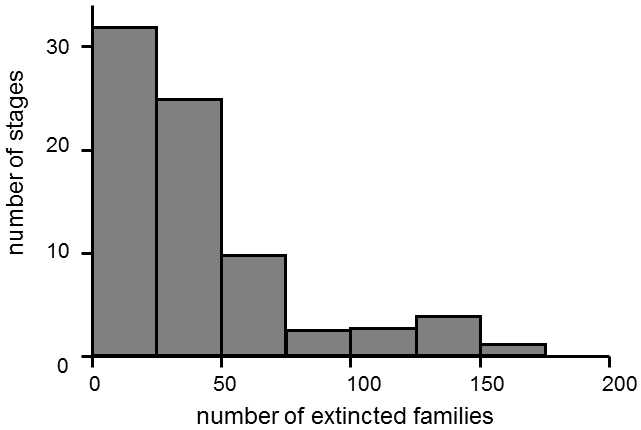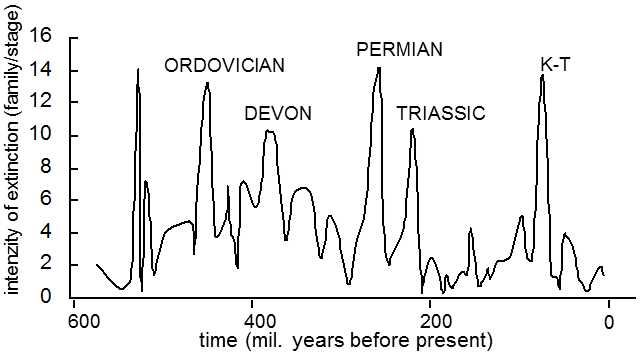XXII.5 The frequency of extinctions oscillates drastically in different periods in the history of life; yet in practice we usually distinguish between mass extinctions and background extinctions
Species became extinct throughout all the periods in the history of the Earth.However, relatively few species become extinct in some periods while, at other times, the rate of extinction, i.e. the number of species that became extinct over a certain time interval, temporarily increased drastically (Fig. XXII.2.).

Fig. XXII.2 Variability of the rate of extinction in the Phanerozoic. The histogram depicts the distribution of the speeds of extinction of marine fauna. The rates are expressed as the number of families that died out during a single stage. The right-hand part of the histogram contains the stages during which mass extinction occurred. It is apparent from the histogram that relatively few families have died out over most of the history of the Earth. However, there were a number of periods during which more than 100 families became extinct. Data taken from Sepkoski 1989 (Sepkoski, 1989), modified according to Newman 1999 (Newman & Palmer, 2003).
On the basis of Sepkoski’s database of 17,621 genera of marine fauna, it has been estimated that the average risk of extinction of a species is 0.25 per million years.However, this value was calculated as an average of the negligible risk of extinction over long periods of time and the very high risk during other periods (Raup 1991).In some periods, the majority of existing species became extinct almost at a single instant, so that even entire higher taxa died out. Extinction is usually classified as mass extinction and “normal” extinction, which is usually termed background extinction.Sometimes, only the “big five” extinctions are classified in the category of mass extinctions, i.e. extinctions at the end of the Ordovician, in the later Devonian, at the end of the Permian, Triassic and Cretaceous (Fig. XXII.3).Simultaneously, some authors do not consider the

Fig. XXII.3 Changes in the intensity of extinction of marine fauna during the Phanerozoic. The graph depicts peaks of extinction rates during the periods of mass extinction included in the “big five”. The extremely intense rate of extinction at the beginning of the Cambrian is not included in the mass extinction in the Phanerozoic. Data from (Sepkoski, 1989), modified according to Newman (1999).
extinctions before the end of the Devonian and at the end of the Triassic to be real mass extinctions as, in contrast to other periods, the mass extinction was not accompanied by a substantial reduction in the overall biodiversity (Kerr 2001). However, fundamentally, it is highly questionable whether there is actually a difference in principle between mass and background extinction.There were certainly more than five periods with elevated intensity of extinction.In all probability, these periods differed both in the intensity, i.e. number of species affected, and in selectivity.However, there were smooth transitions in both the intensity and selectivity of the extinctions and there were also only rather loose correlations between the selectivities and intensities.For a number of reasons, it is practical to classify extinction as mass and background and thus this will be retained here.However, it is necessarily to constantly bear in mind that the individual periods of extinction always had a specific cause and specific course and that any generalization on the differences between mass and background extinction can hold only under certain conditions.
